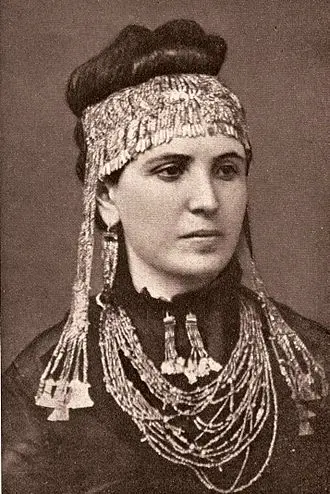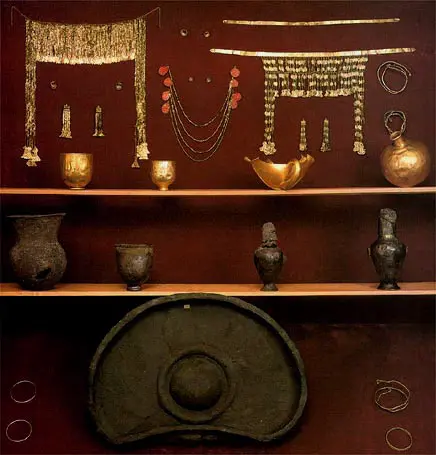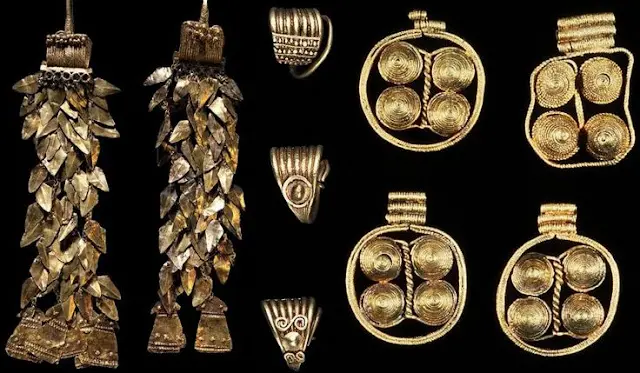The ancient world is replete with captivating relics that carry the tales of long-vanished civilizations, each artifact a window into the mysteries of bygone eras. Among these captivating treasures is the fabled Priam’s Treasure, a collection of precious artifacts that purportedly belonged to King Priam of Troy, immortalized in Homer’s epic “The Iliad.” This exceptional hoard not only exemplifies the splendor of ancient Troy but also serves as a cornerstone for both historical debates and the thrilling field of archaeology.
Discovery and Historical Context
.webp)
In 1873, the renowned businessman and amateur archaeologist Heinrich Schliemann undertook excavations at what he believed was the site of ancient Troy, driven by his lifelong dream of uncovering the physical reality behind Homer’s epics. His discovery of Priam’s Treasure in the ruins brought a wave of excitement and skepticism in equal measure. The site, now confirmed to be historical Troy, revealed layers of civilization, offering a snapshot of life over several millennia.
The Discovery of Troy

Schliemann’s excavations at the site of Hisarlik, in modern-day Turkey, uncovered a series of ancient settlements, each built upon the ruins of its predecessor. Through his meticulous work, he was able to identify the location of the legendary city of Troy, a revelation that captivated the world and paved the way for further archaeological explorations.
Components of Priam’s Treasure
Priam’s Treasure, unearthed by Heinrich Schliemann in the ancient ruins of Troy, consists of a stunning array of artifacts, each narrating a different aspect of historical and cultural life during the late Bronze Age. Among the most significant items found are gold diadems, silver vases, and various copper weapons, which provide insight into the artistic, societal, and martial practices of the time.

Gold Diadems: The treasure included several exquisite gold diadems, which are thought to have been worn by Troy’s royalty or high-ranking nobility. These delicate pieces are intricately designed, featuring filigree work that showcases the advanced goldsmithing skills of the era. The diadems symbolize the wealth and status of their owners and are often interpreted as ceremonial rather than everyday adornments.
Silver Vases: The collection also contains numerous silver vases, some of which bear intricate designs and inscriptions. These vases were likely used for both practical purposes, such as storing precious oils and wines, and ceremonial functions, such as ritual offerings to the gods. The craftsmanship of these vases highlights the aesthetic values of the Trojans and their ability to work with a variety of materials.
Copper Weapons: Among the more utilitarian objects in Priam’s Treasure are the copper weapons, including swords, daggers, and axes. These items not only signify the martial culture of ancient Troy but also reflect the technological advancements in metalwork. The presence of these weapons in the treasure suggests their importance in both defensive warfare and ceremonial contexts, possibly used as offerings or funerary goods for fallen warriors.
The Odyssey of Priam’s Treasure

After its excavation, Priam’s Treasure led a tumultuous existence, changing hands and locations multiple times due to war and politics. Currently housed in the Pushkin Museum in Moscow, the treasure has been the subject of ongoing disputes between Turkey, Germany, and Russia, each staking cultural and historical claims over the hoard.
Cultural and Mythological Significance

The artifacts from Priam’s Treasure are steeped in cultural and mythological importance. They are believed to connect directly to the tales of the Trojan War, echoing the stories of heroism and tragedy that have been passed down through generations. These connections are vital for understanding the blend of history and legend that characterizes much of ancient Greek literature.
Impact on Modern Archaeology

The discovery of Priam’s Treasure has had a lasting impact on archaeological practices. It highlighted the need for more meticulous, scientifically informed methods and sparked a global conversation on the ethics of artifact removal and cultural heritage preservation.

Priam’s Treasure remains a symbol of archaeological triumph and controversy. Its story is a compelling chapter in the saga of human history, echoing the complex interplay between myth and reality, and between the past and its impact on the present. As we delve deeper into the mysteries of ancient civilizations, the legacy of Priam’s Treasure continues to captivate and inspire, reminding us of the enduring power of the human spirit to uncover the secrets of the past.
